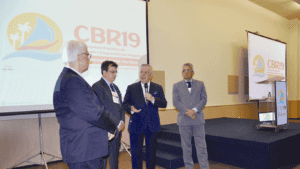The rapid technological development observed in the last three decades has led to the emergence of highly sophisticated diagnostic imaging equipment, capable of producing images that allow a close morphological correlation with the macroscopy of anatomopathological studies. An example of this evolution is the high-resolution computed tomography technique, combined with volumetric acquisitions through the helical system of multiple detectors applied to the study of the thorax, particularly the lungs.
Over the last few years, there has been a significant increase and growing interest in the radiological community in diagnostic imaging of the chest, stimulating the vocation of young professionals.
At the same time, wide dissemination of the specialty has been observed in courses, conferences and congresses, in addition to the rich production of excellent publications, in high-impact national and international journals, of studies developed by thoracic radiologists in all regions of our country, who informally formed a very cohesive group aligned with the same ideals, adding new participants every year. In this way, Brazilian thoracic radiology has been gaining international notoriety, which enables constant exchange with foreign societies of great prominence in this area.
Given this scenario, we proposed the creation of a formal entity, linked to the Brazilian College of Radiology and Imaging Diagnosis (CBR), as a component of the Scientific Committee and with the fantasy brand called Grupo Brasileiro de Radiologia Thoracica (GBRT). the GRBT Its purpose will be to integrate all radiologists interested in thoracic diseases and thus leverage the development of the specialty in Brazil and obtain institutional representation abroad.
On the last October 10, 2019, during the 48th Brazilian Congress of Radiology and Diagnostic Imaging (CBR19), which took place in the city of Fortaleza (CE), the CBR represented by doctors Alair Sarmet Santos and Valdair Muglia, respectively president and director of the College, communicated to the radiological community present in the room where the chest program was carried out the creation of the GBRT which will have in its directive composition the doctors: Arthur Soares Souza Júnior (coordinator), Edson Marchiori (vice-coordinator) and Cesar A. by Araújo Neto (Secretary).
In due course, there will be a wide communication on criteria for the integration of those interested in thoracic radiology to the newly created GBRT.
Cordial greetings,
doctor Arthur Soares Souza Junior
GBRT coordinator




